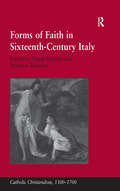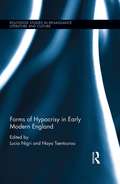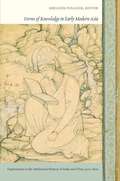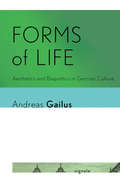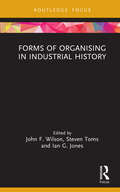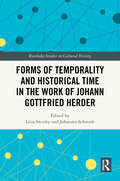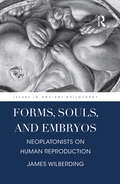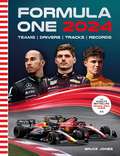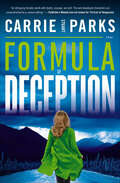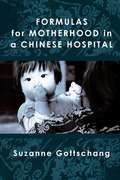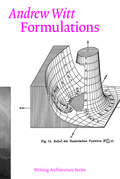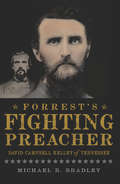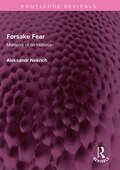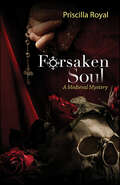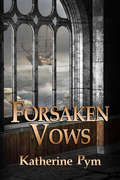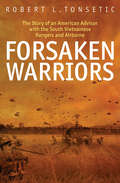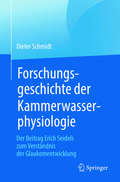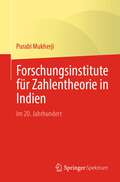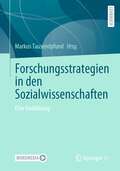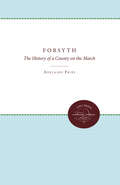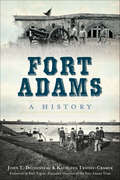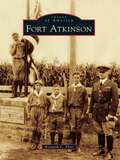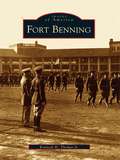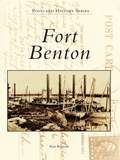- Table View
- List View
Forms of Faith in Sixteenth-Century Italy (Catholic Christendom, 1300-1700)
by Matthew TreherneThe sixteenth century was a period of tumultuous religious change in Italy as in Europe as a whole, a period when movements for both reform and counter-reform reflected and affected shifting religious sensibilities. Cinquecento culture was profoundly shaped by these religious currents, from the reform poetry of the 1530s and early 1540s, to the efforts of Tridentine theologians later in the century to renew Catholic orthodoxy across cultural life. This interdisciplinary volume offers a carefully balanced collection of essays by leading international scholars in the fields of Italian Renaissance literature, music, history and history of art, addressing the fertile question of the relationship between religious change and shifting cultural forms in sixteenth-century Italy. The contributors to this volume are throughout concerned to demonstrate how a full understanding of Cinquecento religious culture might be found as much in the details of the relationship between cultural and religious developments, as in any grand narrative of the period. The essays range from the art of Cosimo I's Florence, to the music of the Confraternities of Rome; from the private circulation of religious literature in manuscript form, to the public performances of musical laude in Florence and Tuscany; from the art of Titian and Tintoretto to the religious poetry of Vittoria Colonna and Torquato Tasso. The volume speaks of a Cinquecento in which religious culture was not always at ease with itself and the broader changes around it, but was nonetheless vibrant and plural. Taken together, this new and ground-breaking research makes a major contribution to the development of a more nuanced understanding of cultural responses to a crucial period of reform and counter-reform, both within Italy and beyond.
Forms of Hypocrisy in Early Modern England (Routledge Studies in Renaissance Literature and Culture)
by Naya Tsentourou Lucia NigriThis collection examines the widespread phenomenon of hypocrisy in literary, theological, political, and social circles in England during the years after the Reformation and up to the Restoration. Bringing together current critical work on early modern subjectivity, performance, print history, and private and public identities and space, the collection provides readers with a way into the complexity of the term, by offering an overview of different forms of hypocrisy, including educational practice, social transaction, dramatic technique, distorted worship, female deceit, print controversy, and the performance of demonic possession. Together these approaches present an interdisciplinary examination of a term whose meanings have always been assumed, yet never fully outlined, despite the proliferation of publications on aspects of hypocrisy such as self-fashioning and disguise. Questions the chapters collectively pose include: how did hypocritical discourse conceal concerns relating to social status, gender roles, religious doctrine, and print culture? How was hypocrisy manifest materially? How did different literary genres engage with hypocrisy?
Forms of Knowledge in Early Modern Asia: Explorations in the Intellectual History of India and Tibet, 1500-1800
by Sheldon PollockIn the past two decades, scholars have transformed our understanding of the interactions between India and the West since the consolidation of British power on the subcontinent around 1800. While acknowledging the merits of this scholarship, Sheldon Pollock argues that knowing how colonialism changed South Asian cultures, particularly how Western modes of thought became dominant, requires knowing what was there to be changed. Yet little is known about the history of knowledge and imagination in late precolonial South Asia, about what systematic forms of thought existed, how they worked, or who produced them. This pioneering collection of essays helps to rectify this situation by addressing the ways thinkers in India and Tibet responded to a rapidly changing world in the three centuries prior to 1800. Contributors examine new forms of communication and conceptions of power that developed across the subcontinent; changing modes of literary consciousness, practices, and institutions in north India; unprecedented engagements in comparative religion, autobiography, and ethnography in the Indo-Persian sphere; and new directions in disciplinarity, medicine, and geography in Tibet. Taken together, the essays in Forms of Knowledge in Early Modern Asia inaugurate the exploration of a particularly complex intellectual terrain, while gesturing toward distinctive forms of non-Western modernity. Contributors. Muzaffar Alam, Imre Bangha, Aditya Behl, Allison Busch, Sumit Guha, Janet Gyatso, Matthew T. Kapstein, Franoise Mallison, Sheldon Pollock, Velcheru Narayana Rao, Kurtis R. Schaeffer, Sunil Sharma, David Shulman, Sanjay Subrahmanyam, Mohamad Tavakoli-Targhi
Forms of Life: Aesthetics and Biopolitics in German Culture (Signale: Modern German Letters, Cultures, and Thought)
by Andreas GailusIn Forms of Life, Andreas Gailus argues that the neglect of aesthetics in most contemporary theories of biopolitics has resulted in an overly restricted conception of life. He insists we need a more flexible notion of life: one attuned to the interplay and conflict between its many dimensions and forms. Forms of Life develops such a notion through the meticulous study of works by Kant, Goethe, Kleist, Nietzsche, Wittgenstein, Benn, Musil, and others. Gailus shows that the modern conception of "life" as a generative, organizing force internal to living beings emerged in the last decades of the eighteenth century in biological thought. At the core of this vitalist strand of thought, Gailus maintains, lies a persistent emphasis on the dynamics of formation and deformation, and thus on an intrinsically aesthetic dimension of life. Forms of Life brings this older discourse into critical conversation with contemporary discussions of biopolitics and vitalism, while also developing a rich conception of life that highlights, rather than suppresses, its protean character. Gailus demonstrates that life unfolds in the open-ended interweaving of the myriad forms and modalities of biological, ethical, political, psychical, aesthetic, and biographical systems.
Forms of Organising in Industrial History (Routledge Focus on Industrial History)
by John F. Wilson, Steven Toms and Ian G. JonesThis shortform book presents key peer-reviewed research selected by expert series editors and contextualised by new analysis from each author on different forms of organising British industry. With contributions on the strengths and weaknesses of the holding company structure, government organisation of industry during war time, the effects of forms of organisation on innovation, and debates over the suitability of international comparisons, this volume provides an array of fascinating insights into industrial history. Of interest to business and economic historians, this shortform book also provides analysis and illustrative case-studies that will be valuable reading across the social sciences.
Forms of Temporality and Historical Time in the Work of Johann Gottfried Herder (Routledge Studies in Cultural History)
by Johannes Schmidt Liisa SteinbyThis edited collection is the first volume solely dedicated to research on Johann Gottfried Herder’s understanding of history, time, and temporalities.Although his ideas on time mark an important transition period that advanced the emergence of the modern world, scholars have rarely addressed Herder’s temporalities. In eight chapters, the volume examines and illuminates Herder’s conception of human freedom in connection with time; the importance of the concept of forces (Kräfte) for a dynamic ontology; human beings’ sensuous experience of inner and external temporality; Herder’s conception of Bildung, speculations on extra-terrestrial beings and on different perceptions of time; the mythological figure Nemesis and Herder’s view of the past and the future; the temporal dimension in Herder’s aesthetics; and Herder’s biblical studies in relationship to divine infinitude and human temporality. The volume concludes by outlining the influence of Herder’s understanding of time on following generations of thinkers.Forms of Temporality and Historical Time in the Work of Johann Gottfried Herder is ideal for scholars, graduates, and postgraduates interested in Herder’s metaphysics, epistemology, and philosophy of history, as well as any scholar concerned with eighteenth-century concepts of time and the emergence of the modern world at the beginning of the nineteenth century.
Forms, Souls, and Embryos: Neoplatonists on Human Reproduction (Issues in Ancient Philosophy)
by James WilberdingForms, Souls, and Embryos allows readers coming from different backgrounds to appreciate the depth and originality with which the Neoplatonists engaged with and responded to a number of philosophical questions central to human reproduction, including: What is the causal explanation of the embryo’s formation? How and to what extent are Platonic Forms involved? In what sense is a fetus ‘alive,’ and when does it become a human being? Where does the embryo’s soul come from, and how is it connected to its body? This is the first full-length study in English of this fascinating subject, and is a must-read for anyone interested in Neoplatonism or the history of medicine and embryology.
Formula One 2024
by Bruce JonesThe world's bestselling Grand Prix handbook is back revised and fully updated for the new season.This is the definitive guide to Formula 1 in 2024. A complete examination of all the teams racing this season, every driver and all the tracks featured in the packed Grand Prix calendar.Also including a full review of the 2023 season and a breakdown of the revised rules and regulations for 2024, this indispensable guidebook features last season's drivers' and constructors' world championship results - as well as a fill-in chart for 2024, so each book becomes your own personalised guide to the year's action.Written by bestselling F1 author Bruce Jones and containing dozens of breathtaking photographs and detailed circuit illustrations plus a statistics section highlighting the major records in F1 history, this is the only guide you'll need for the racing action ahead.
Formula One 2024
by Bruce JonesThe world's bestselling Grand Prix handbook is back revised and fully updated for the new season.This is the definitive guide to Formula 1 in 2024. A complete examination of all the teams racing this season, every driver and all the tracks featured in the packed Grand Prix calendar.Also including a full review of the 2023 season and a breakdown of the revised rules and regulations for 2024, this indispensable guidebook features last season's drivers' and constructors' world championship results - as well as a fill-in chart for 2024, so each book becomes your own personalised guide to the year's action.Written by bestselling F1 author Bruce Jones and containing dozens of breathtaking photographs and detailed circuit illustrations plus a statistics section highlighting the major records in F1 history, this is the only guide you'll need for the racing action ahead.
Formula of Deception: A Novel
by Carrie Stuart Parks&“I love Carrie Stuart Parks&’s skill in writing characters with hysterical humor, unwitting courage and page-turning mystery. I hope my readers won&’t abandon me completely when they learn about her!&” —Terri Blackstock, USA TODAY bestselling author of If I Run, If I&’m Found, and If I LiveAn artist hiding from an escaped killer uncovers one of World War II&’s most dangerous secrets—a secret that desperate men will do anything to keep hidden.After the murder of her twin sister, Murphy Anderson changed her name and appearance and moved to Kodiak, Alaska, to avoid the press and publicity. But when local authorities discover she&’s an artist and request her help in drawing a dying man&’s memories, she unintentionally ends up in the limelight again—and back in the killer&’s crosshairs.The deathbed confessions of an Alaskan hunter have Murphy drawing the five bodies he discovered on remote Ruuwaq Island ten years ago. But what investigators find has them mystified. Evidence suggests that the bodies were deliberately destroyed, and what they uncover in an abandoned Quonset hut from World War II only brings more questions.As one by one the investigators who were at the hut die, Murphy knows there is something much darker at stake. What happened on this island during the war? And who is willing to kill to keep its secrets buried?
Formulas for Motherhood in a Chinese Hospital
by Suzanne GottschangWhat happens to pregnant women when the largest country in the world implements a global health policy aimed at reorganizing hospitals and re- training health care workers to promote breastfeeding? Since 1992, the Chinese government has led the world in reorganizing more than 7,000 hospitals into “Baby- Friendly” hospitals. The initiative’s goal, overseen by UNICEF and the World Health Organization, is to promote the practice of breastfeeding by reorganizing hospital routines, spaces, and knowledge in maternity wards and obstetrics clinics. At the same time, China’s hospitals in the mid- 1990s operated as sites where the effects of economic reform and capitalism increasingly blurred the boundaries between state imperatives to produce healthy future citizens and the flexibility accorded individuals through their participation in an emerging consumer culture. Formulas for Motherhood follows a group of women over eighteen months as they visited a Beijing Baby- Friendly Hospital over the course of their pregnancies and throughout their postpartum recoveries. The book shows how the space of the hospital operates as a microcosm of the larger social, political, and economic forces that urban Chinese women navigate in the process of becoming a mother. Relations between biomedical practices, heightened expectations of femininity and sexuality demanded by a consumer culture, alongside international and national agendas to promote maternal and child health, reveal new agents of maternal governance emerging at the very moment China’s economy heats up. This ethnography provides insight into how women’s creative pragmatism in a rapidly changing society leads to their views and decisions about motherhood.
Formulations: Architecture, Mathematics, Culture (Writing Architecture)
by Andrew WittAn investigation of mathematics as it was drawn, encoded, imagined, and interpreted by architects on the eve of digitization in the mid-twentieth century.In Formulations, Andrew Witt examines the visual, methodological, and cultural intersections between architecture and mathematics. The linkages Witt explores involve not the mystic transcendence of numbers invoked throughout architectural history, but rather architecture&’s encounters with a range of calculational systems—techniques that architects inventively retooled for design. Witt offers a catalog of mid-twentieth-century practices of mathematical drawing and calculation in design that preceded and anticipated digitization as well as an account of the formal compendia that became a cultural currency shared between modern mathematicians and modern architects. Witt presents a series of extensively illustrated &“biographies of method&”—episodes that chart the myriad ways in which mathematics, particularly the mathematical notion of modeling and drawing, was spliced into the creative practice of design. These include early drawing machines that mechanized curvature; the incorporation of geometric maquettes—&“theorems made flesh&”—into the toolbox of design; the virtualization of buildings and landscapes through surveyed triangulation and photogrammetry; formal and functional topology; stereoscopic drawing; the economic implications of cubic matrices; and a strange synthesis of the technological, mineral, and biological: crystallographic design. Trained in both architecture and mathematics, Witt uses mathematics as a lens through which to understand the relationship between architecture and a much broader set of sciences and visual techniques. Through an intercultural exchange with other disciplines, he argues, architecture adapted not only the shapes and surfaces of mathematics but also its values and epistemic ideals.
Forrest's Fighting Preacher: David Campbell Kelley of Tennessee (Civil War Series)
by Michael R. BradleyEvery leader needs a trusted confidant. For Nathan Bedford Forrest, one of the Civil War's greatest military minds, that man was David Campbell Kelley. Kelley began adulthood in the clergy, serving for two years as a missionary in China and returning home just a year before the Civil War. He then raised a company of cavalry from his family's large congregation that became part of Forrest's original regiment. Kelley quickly became Forrest's second in command, assisting in some of his most daring engagements, offering support in key decisions and serving as his unofficial chaplain. Following the war, Kelley returned to preaching, helped establish Vanderbilt University and launched a campaign for governor of Tennessee. Now, for the first time, author Michael R. Bradley brings Kelley's dynamic life to the fore.
Forsake Fear: Memoirs of an Historian (Routledge Revivals)
by Aleksandr M NekrichFirst published in 1991, Forsake Fear is the history of historians in post-war Soviet society. Nekrich, in recounting his own brave story, tells us how he dared to challenge the prevailing conformism. From his unique ad riveting vantage point, Nekrich also provides a broader picture of Soviet society and its intellectual life during high Stalinism and after. In 1945, Aleksandr Nekrich returned from the front. He spent the next three decades at the centre of the Soviet historical profession. He maintained friendships with such noted public figures such as Ivan Maisky, Soviet ambassador to Britain, and Abram Deborin, whom Stalin branded a ‘Menshevik-idealist.’ He also encountered writers, artists, scientists, and even spies. Among Soviet historians, Nekrich was the only one who dared to break the taboo and declare that the Stalin-Hitler pact was advantageous to Nazi Germany. This book will be of interest to students of history, literature, international relations, and political science.
Forsaken Soul (Medieval Mysteries #5)
by Priscilla RoyalThe summer of 1273 is peaceful for most of England, but not for Prioress Eleanor of Tyndal Priory. Her friend, Crowner Ralf, is newly widowed with a baby. And her new anchoress is welcoming visitors to her window at night: one of them a man the prioress secretly loves. Now his loyalty to her as head of Tyndal Priory is suspect. Then Martin the Cooper is poisoned at the local inn. Martin had a wealth of enemies. The killer could be any of them. No one likes the direction the evidence points, but God's justice must be rendered even for the most forsaken soul."Against an authentic backdrop of medieval life and lore, Royal once again brings alive characters who are true to their period yet exhibit emotions and feelings that 21st-century readers will recognize as their own." —Publishers Weekly starred reviewPriscilla Royal lives in Northern California. Forsaken Soul is her fifth Medieval Mystery. www.priscillaroyal.com
Forsaken Vows
by Katherine PymLondon 1661, the new king is on the throne, but old religious beliefs and Medieval superstition still prevail. Catholics are not tolerated in this new era. Edgar and Emmatha Torbet are papists and fraternal twins, which means their mother was an adulteress. One of them is a legitimate heir, the other is a bastard. Which one of them is it?
Forsaken Warriors
by Robert TonseticAn inside account of the South Vietnamese elites who strove to carry on the war against the Communists during the US Army's withdrawal . . . The book is a personal memoir of the author's service as a US Army advisor during the end stages of America's involvement in Vietnam. During the period 1970-71, the US was beginning to draw down its combat forces, and the new watchword was "Vietnamization." It was the period when the will of the US to prosecute the war had slipped, and transferring responsibility to the South Vietnamese was the only remaining hope for victory. The author served as a US Army advisor to South Vietnamese Ranger and Airborne units during this critical period. The units that the author advised spearheaded several campaigns in South Vietnam, Cambodia, and Laos, as the US combat units withdrew. Often outnumbered and outgunned, the elite Ranger and Airborne units fought Viet Cong and North Vietnamese units in some of the most difficult terrain in Southeast Asia, ranging from the legendary U Minh forest and Mo So mountains in the Mekong Delta to the rugged hills of southern Laos. The role of the small US advisory teams is fully explained in the narrative. With little support from higher headquarters, these teams accompanied the Vietnamese units on highly dangerous combat operations over which they had no command or control authority. When US advisors were restricted from accompanying South Vietnamese forces on cross-border operations in Cambodia and especially Laos, the South Vietnamese forces were badly mauled, raising concerns about their readiness and training, and their ability to operate without their US advisors. As a result, a major effort was placed on training these forces, while the clock continued to run on the US withdrawal. Having served with a US infantry battalion during the peak years of the US involvement in Vietnam, Robert Tonsetic--the acclaimed author of Days of Valor--is able to view the war through two different prisms and offer criticisms and an awareness of the South Vietnamese armed forces were ultimately defeated.
Forschungsgeschichte der Kammerwasserphysiologie: Der Beitrag Erich Seidels zum Verständnis der Glaukomentwicklung
by Dieter SchmidtEnde des 19. und zu Beginn des 20. Jahrhunderts gab es sehr unterschiedliche experimentelle Befunde zur Physiologie der Kammerwasserwege. Mit seinen Untersuchungen zeigte Erich Seidel, dass der Ziliarkörper das Sekretionsorgan des Auges ist. Seine bedeutenden zahlreichen und umfangreichen Publikationen, die sich mit Fragen der intraokularen Flüssigkeitsströmung und mit dem Glaukom befassten, erschienen in der Zeit von 1916 bis 1932. Mit seinen neuen Erkenntnissen setzte er sich trotz Widerspruchs mehrerer Augenärzte durch und trug damit entscheidend zum besseren Verständnis der Glaukomentwicklung bei.
Forschungsinstitute für Zahlentheorie in Indien: Im 20. Jahrhundert
by Purabi MukherjiDieses Buch versucht, die schrittweise Entwicklung der wichtigsten Forschungsinstitute zur Zahlentheorie in Südindien, Punjab, Mumbai, Bengalen und Bihar zu beschreiben, einschließlich der Gründung des Tata Institute of Fundamental Research (TIFR) in Mumbai, einem bahnbrechenden Ereignis in der Geschichte der Zahlentheorie-Forschung in Indien. Die Forschung zur Zahlentheorie in Indien begann in der modernen Zeit mit dem Auftreten des ikonischen Genies Srinivasa Ramanujan, das Mathematiker auf der ganzen Welt inspirierte. Das Buch diskutiert die nationale und internationale Wirkung der Forschung indischer Zahlentheoretiker und enthält eine sorgfältig zusammengestellte, umfassende Bibliographie bedeutender indischer Zahlentheoretiker des 20. Jahrhunderts. Es ist wichtig für die historische Dokumentation und eine wertvolle Ressource für Forscher auf diesem Gebiet. Das Buch diskutiert auch kurz die Bedeutung der Zahlentheorie in der modernen Mathematik, einschließlich Anwendungen der Ergebnisse indigener Zahlentheoretiker in praktischen Bereichen. Da das Buch aus der Perspektive der Wissenschaftsgeschichte geschrieben ist, wurden technische Fachbegriffe und mathematische Ausdrücke so weit wie möglich vermieden.Die Übersetzung wurde mit Hilfe von künstlicher Intelligenz durchgeführt. Eine anschließende menschliche Überarbeitung erfolgte vor allem in Bezug auf den Inhalt.
Forschungsstrategien in den Sozialwissenschaften: Eine Einführung
by Markus TausendpfundTrotz unterschiedlicher Themen und Fragestellungen sind Forschende und Studierende bei der Durchführung eines Forschungsprojekts immer wieder mit vergleichbaren Herausforderungen konfrontiert: eine relevante Forschungsfrage muss entwickelt und der meist umfangreiche Forschungsstand prägnant präsentiert werden. Daran anknüpfend müssen die zentralen Konzepte eines Forschungsprojekts spezifiziert und valide Operationalisierungen dieser Konzepte entwickelt werden. Schließlich müssen Untersuchungsobjekte ausgewählt und die geeignete Untersuchungsmethode festgelegt werden. Dieser Band behandelt die typischen Herausforderungen eines sozialwissenschaftlichen Forschungsprojekts und bietet Informationen, um diese Herausforderungen (besser) meistern zu können.
Forsyth: The History of a County on the March
by Adelaide L. Fries Stuart Thomas Wright J. Edwin HendricksThis is a carefully researched and completely rewritten version of Adelaide Fries's 1949 history that traced the Forsyth story from its Moravian beginnings through the joining of Winston and Salem and concluded with a forward look to Wake Forest College as a key to future cultural growth. The authors emphasize the contributions of the county beyond the city limits, reflecting the growing social and economic importance of the suburban and rural area in the past twenty-five years.Originally published in 1976.A UNC Press Enduring Edition -- UNC Press Enduring Editions use the latest in digital technology to make available again books from our distinguished backlist that were previously out of print. These editions are published unaltered from the original, and are presented in affordable paperback formats, bringing readers both historical and cultural value.
Fort Adams: A History (Landmarks)
by John T. DuchesneauFort Adams has a rich and illustrious history as defender of Narragansett Bay. On the shores of Newport, Rhode Island, the fort was named for the nation's second president, John Adams. Humbly beginning as an earthwork in 1776, it remained an active fort until its permanent closure in 1950. Fort Adams stood guard during the American Revolutionary War, Mexican-American War, Civil War and Spanish-American War, as well as World Wars I and II. Now a state park, Fort Adams is fully restored to its former glory of days past. Authors John T. Duchesneau and Kathleen Troost-Cramer explore the history of the most notable commanding officers of the fort, the changing role of women within the Fort Adams community and the legacy left behind by the families who called the fort home.
Fort Atkinson (Images of America)
by Kenneth C. FlintFort Atkinson has been called the "top historical spot in Nebraska," the "SAC of 1820," and "America's most important Western outpost." Once the country's largest fortress beyond the Missouri River, its garrison protected America's interests in the burgeoning fur trade, provided a base camp for explorations, played host to famous frontiersmen, and was the site where numerous treaties were signed. But by 1961, Fort Atkinson was endangered. The fort's buildings had vanished over 100 years before. Decades of farming on the land had nearly erased its footprint. A housing development threatened to obliterate the site forever. There was only a marker with a flagpole raised in 1927 by the Daughters of the American Revolution--a lonely object in the midst of an empty plain. This book tells the story of how that lost fortress was restored to become the major state historical park it is today.
Fort Benning (Images of America)
by Kenneth H. Thomas Jr.Established outside Columbus, Georgia in October 1918 by the United States Army as Camp Benning, the base was moved to its permanent location, nine miles south, in June 1919. In 1922, the post was made permanent and was named Fort Benning. Created as the new location of The Infantry School of Arms, Fort Benning became the training post for many of the country's future leaders, as well as a major part of the military experience for hundreds of thousands of American soldiers.The post's current size, more than 180,000 acres, has long made it recognized as one of the largest infantry bases in the world. Named for Gen. Henry L. Benning of Columbus, the installation has had a major impact on the economic and social life of nearby Columbus. Images of America: Fort Benning features vintage photographs and postcards, mostly from 1918 to 1978, showcasing the first 60 years of the base's 85-year history. Included are scenes of the temporary encampment on Macon Road and the early wooden encampment on the Main Post. The permanent buildup from the late 1920s to the early 1940s is shown in photographs of The Infantry School, the Officers' Club, Main Post Chapel, Doughboy Stadium, Gowdy Field, the Jump Towers, Lawson Field, the Cuartel Barracks, and the officers' quarters, as well as Riverside, the Commandant's Home, formerly the Bussey Plantation. Activities and events include military reviews, visits of presidents, and the National Infantry Museum's dedication. Generals who served there and are featured include Bradley, Eisenhower, Marshall, and Patton.
Fort Benton (Postcard History Series)
by Ken RobisonFort Benton, the head of navigation on the Missouri River, is known as the "Birthplace of Montana." Its history spans every era in Montana's development. Founded in 1846 as a fur-trading post, it is Montana's oldest continuous settlement. Arrival of the first steamboats and completion of the Mullan Road in 1860 heralded the steamboat era, bringing gold seekers, merchant princes, scoundrels, soldiers, North West Mounted Police, and eventually women and children to the wild frontier. Then came the railroads, open-range ranching, and homesteaders by the thousands. Today Fort Benton serves the agricultural Golden Triangle and presents its colorful history through cultural tourism.
